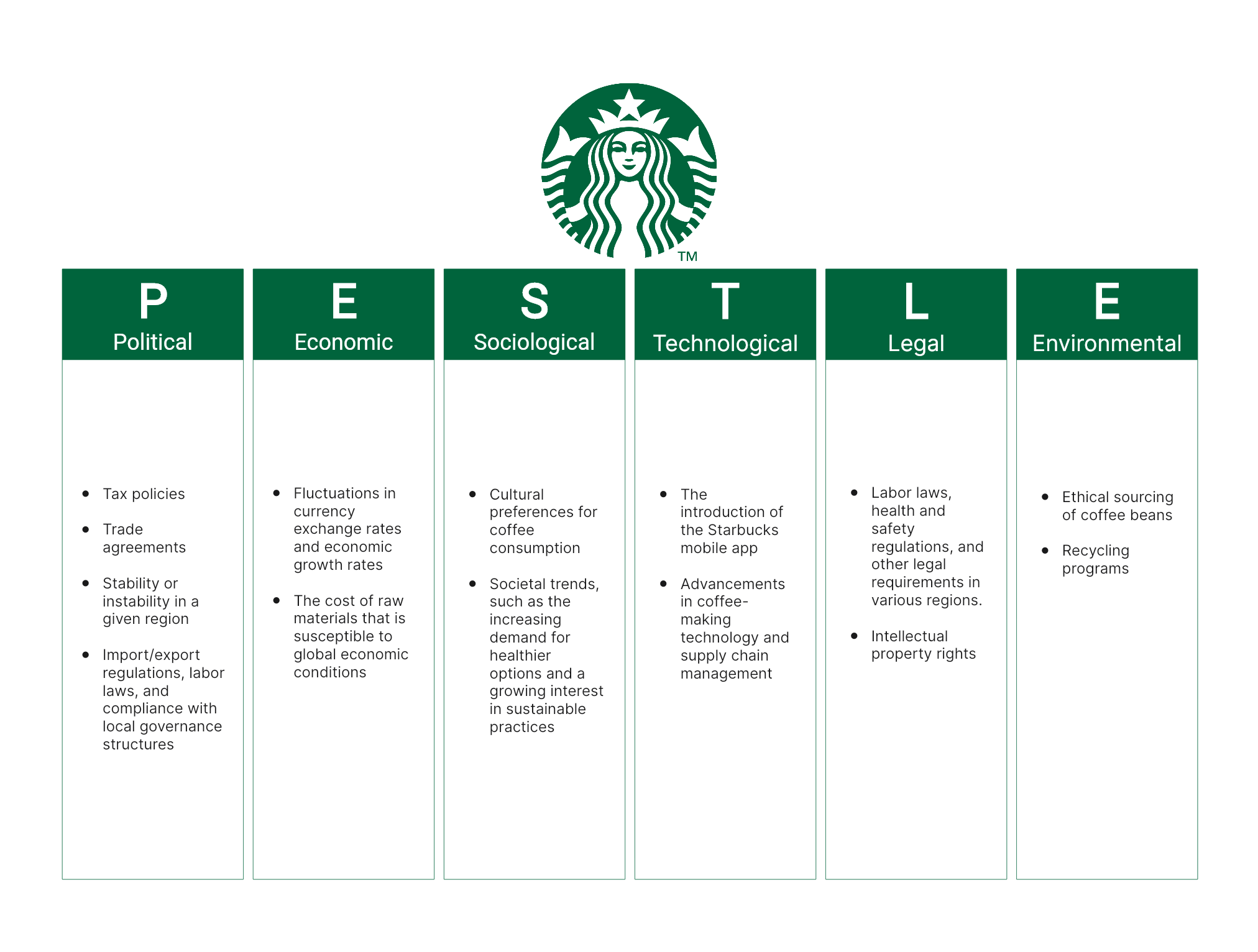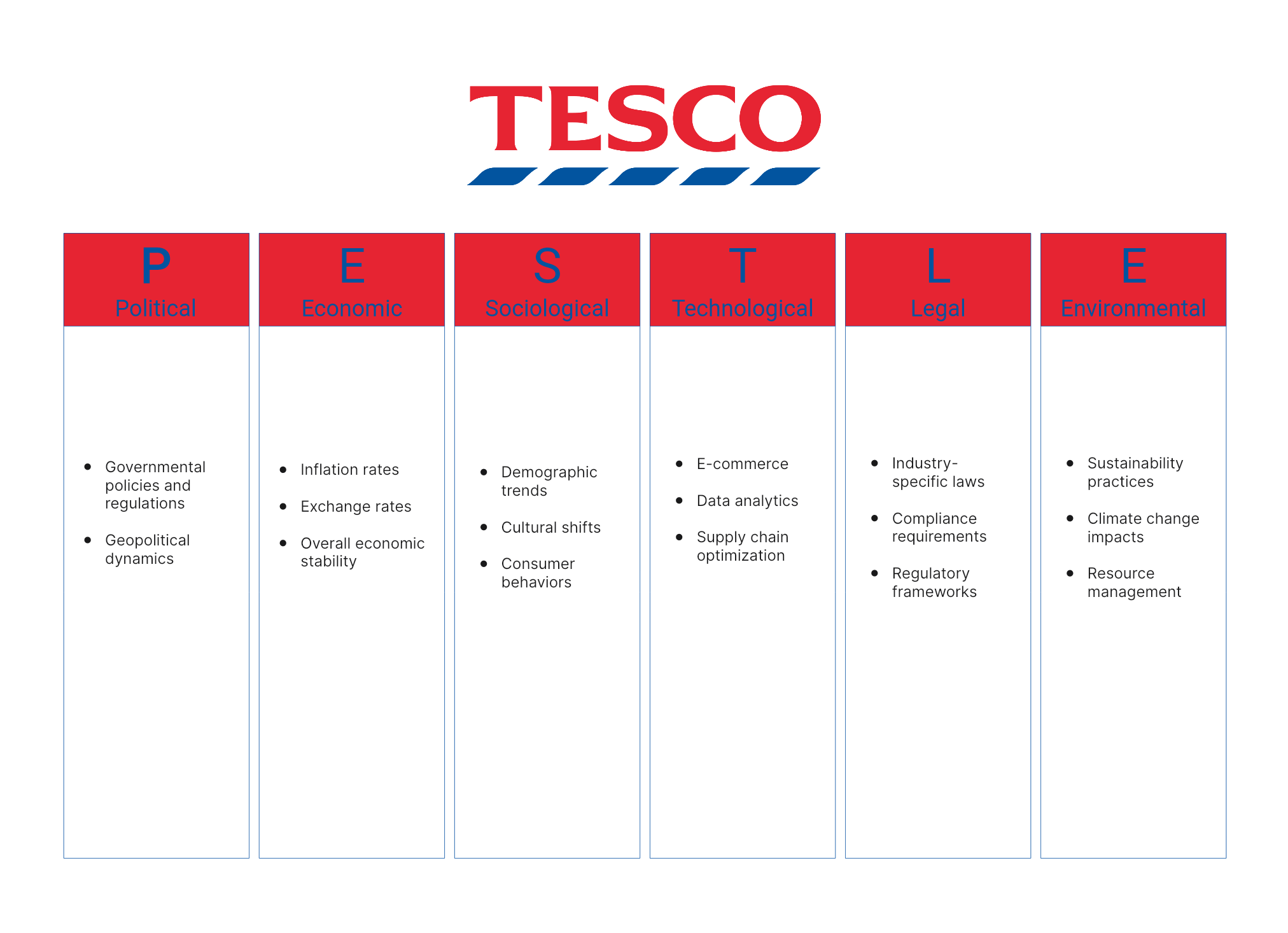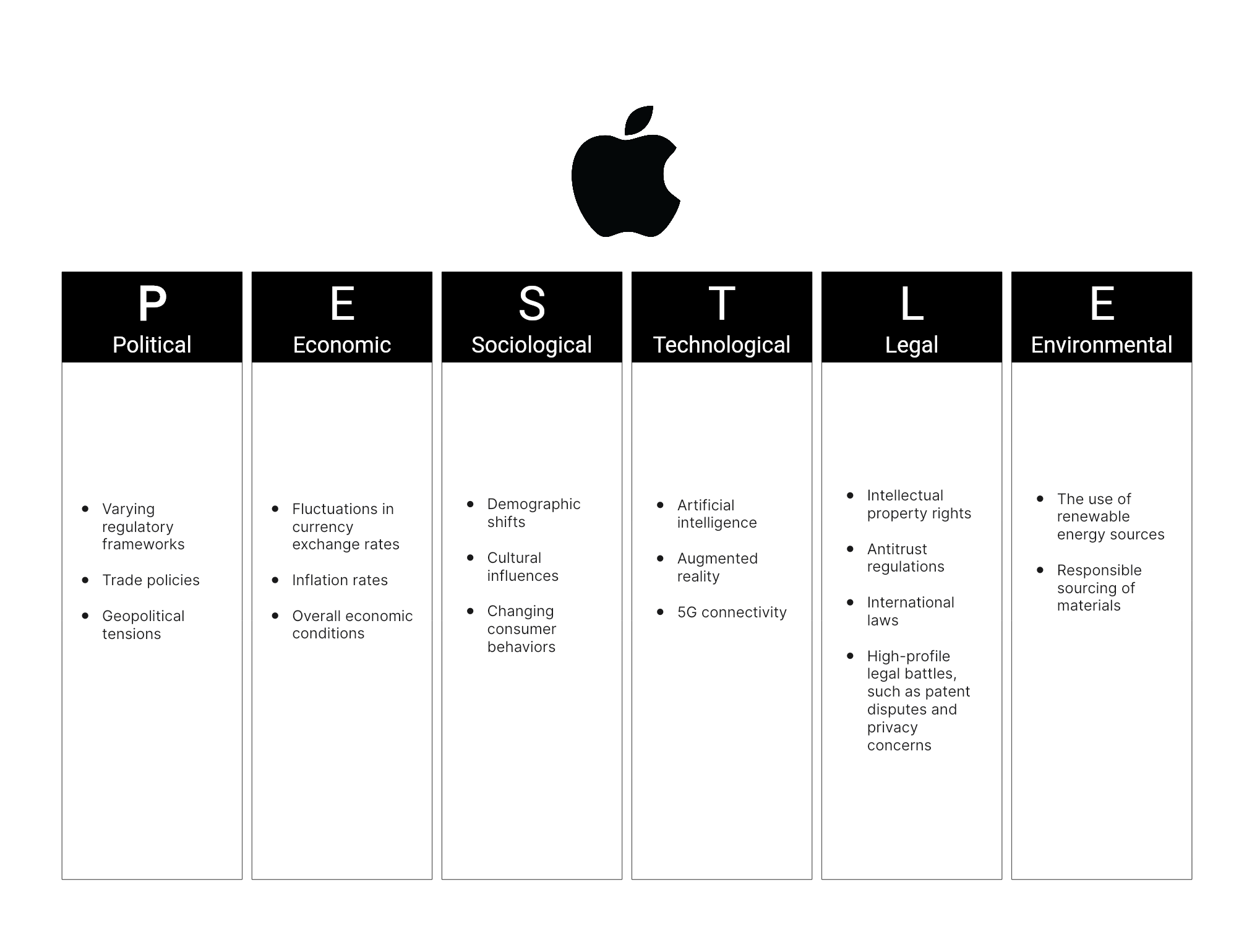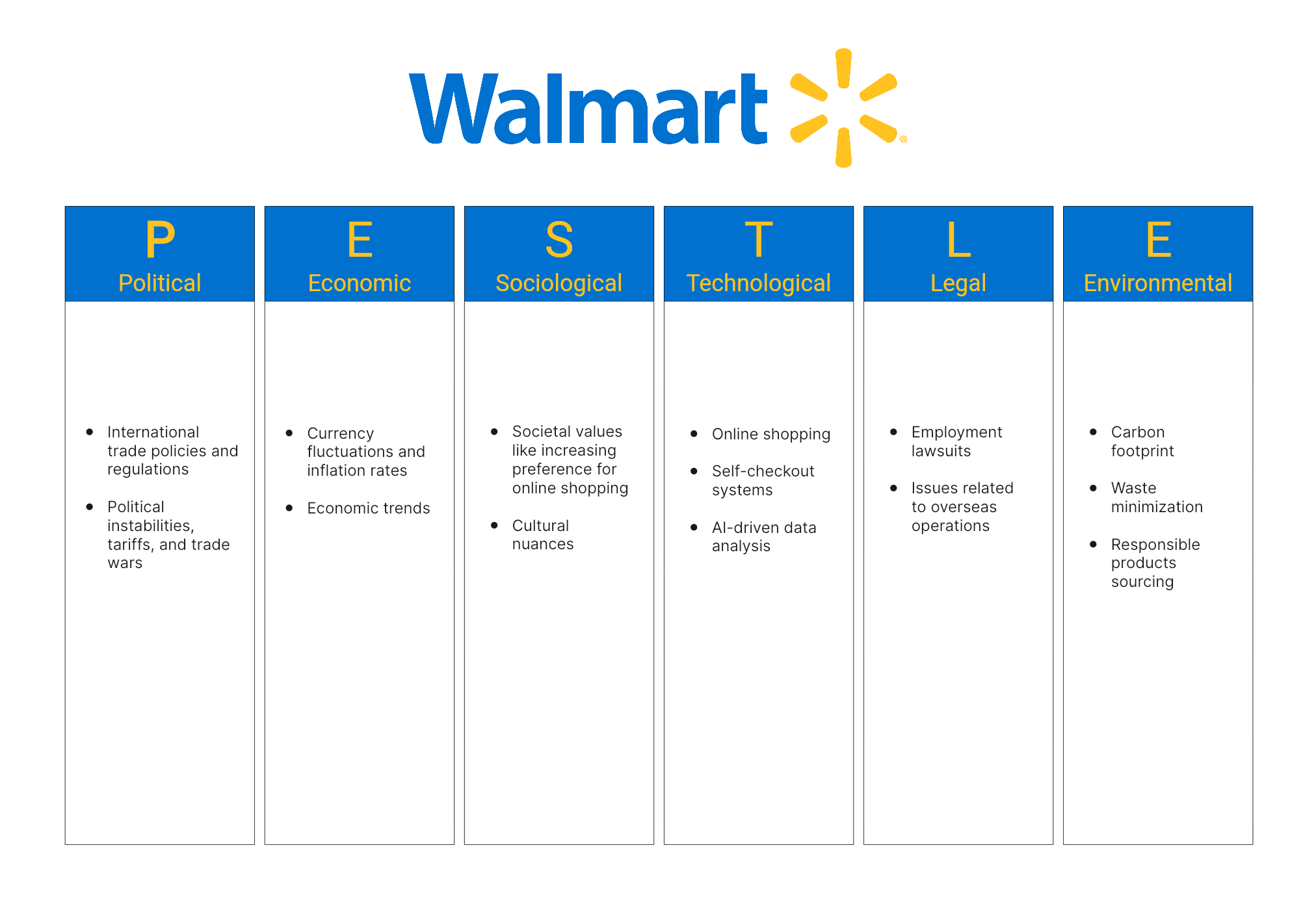What is the PESTLE analysis template
A PESTLE analysis template is a common tool that helps users to understand the impact of external factors on an event/project or an organization. PESTLE is an acronym and encompasses the following areas:
- Political
- Economic
- Social
- Technological
- Legal
- Environmental
The use of a PESTLE analysis template helps users to understand these different factors and how they work together to influence the corporate environment.

The main objective of a pest analysis template is to identify external factors that are related to the business focal point, and understand how they have impacted the event or company you are focusing on. This information can then be used to predict future risks, opportunities, and overall trends. By understanding the external factors that can impact a business, future decisions can be informed, and can help the business or project adapt to the world around it in the most efficient way possible.
Overall, the importance of a PESTLE analysis cannot be undervalued. This tool helps to provide an extensive review and understanding of the external environment that surrounds a business. In turn, this helps the company to develop and grow in ways that maximize opportunity, reduce risk, and in general increase the chances of long-term growth and success.
When to Use the PESTLE Analysis Template
The PESTLE Analysis Template is an invaluable tool that should be utilized in several key instances. Primarily, it's most effective when you're planning to launch a new product or service, or when you're considering entering a new market. This strategic tool provides a comprehensive overview of the political, economic, social, technological, legal and environmental factors that could influence your business operations.
When you're looking to expand your business internationally, the PESTLE Analysis Template can help you understand the intricacies of the foreign market, including potential challenges and opportunities. It's also beneficial when you're assessing the viability of a new project or investment. By understanding the external factors at play, you can make informed decisions that align with your strategic objectives.
Moreover, if there's a significant change in your industry or market conditions, it's advisable to use this template to reassess your situation. Changes in government policies, technological advancements, or shifts in consumer behavior can have profound impacts on your business. Utilizing the PESTLE Analysis Template allows you to anticipate these changes and adapt accordingly.
How to Use BoardMix's PESTLE Analysis Template
Using BoardMix's PESTLE Analysis Template is a straightforward process that can greatly enhance your strategic planning.
Here are some steps to guide you:
Step 1: Start by opening the BoardMix's PESTLE Analysis Template on the BoardMix platform. If you don't have an account, create one. It's a simple and quick process.
Step 2: Once you've opened the template, you'll see six sections representing the six elements of PESTLE - Political, Economic, Social, Technological, Legal, and Environmental.
Step 3: Start filling in each section with relevant data. For the Political section, consider factors such as government policies, political stability, tax regulations etc. For the Economic section, think about economic trends, inflation rates, exchange rates etc. Similarly, fill in the other sections with appropriate information.
Step 4: As you fill in each section, try to identify how each factor could impact your business or project. This could be in terms of opportunities or threats.
Step 5: After you've filled all sections of the template, review the information. Look for patterns or significant factors that could have a major impact on your business or project.
Step 6: Based on your analysis, make strategic decisions that will help you take advantage of opportunities and mitigate potential threats.
Remember to update your PESTLE analysis regularly as external factors can change rapidly. By doing so, you'll ensure that your strategies remain relevant and effective.
BoardMix's PESTLE Analysis Template is designed to make this complex analysis more manageable and visual. By using it effectively, you can gain a comprehensive understanding of your business environment and make informed strategic decisions.
10 PESTLE Analysis Examples
A Zara PESTLE analysis examines the external macro-environmental factors that can affect an organization. Let's analyze Zara's business environment using the PESTLE framework:

Starbucks is a globally recognized coffeehouse chain with a presence in over 80 countries. Established in 1971, it has become synonymous with premium coffee and a comfortable café experience.

This section will delve into each component of the Tesco PESTLE analysis, encompassing Political, Economic, Social, Technological, Legal, and Environmental factors, to provide a comprehensive understanding of Tesco's strategic landscape.

Now, let's embark on an in-depth exploration of McDonald's through the lens of a McDonald's PESTLE analysis, dissecting the key factors that influence this global fast-food giant:
Here’s the detailed PESTLE analysis of the Apple company:

A PESTLE analysis of Nestle involves a comprehensive examination of the six key external factors that can significantly impact the company's business environment and strategic decisions. Let's delve into each factor:

Here’s the detailed description of Coca-Cola PESTLE analysis:

Here’s the detailed description of Walmart PESTLE analysis:

Here’s the detailed description of SamsugnPESTLE analysis:

Amazon's enormous global footprint means it's affected by a myriad of external factors. Let's delve deeper into each element of the PESTEL analysis of amazon to understand these influences:

PESTLE Factors
Political
In a PESTLE analysis template, the Political factor refers to laws, policies, government, and political influence on a company or project. Understanding how political factors influence a business helps to ensure that companies stay within legal regulations, but also helps to predict what future political change may look like, and in turn what this may mean for their business (e.g. higher taxes, stricter legislation, etc).
Examples of Political factors to consider:
- Tax policies
How a business is taxed can impact how it develops/grows - certain areas may tax higher, so companies will look to move elsewhere or develop a different target audience to avoid high-tax regions.
- Economic policies
Business policies in general and trade-specific laws and policies can impact the way that a business or project can expand.
- Trade regulations
Understanding national and international relationships and regulations that may impact the way your business wants to grow or develop in certain markets.
- Political stability
Whether or not a government looks as though it is stable (unlikely for the political environment to change much), or unstable (may result in a change in government and significant new policies).
Economic
The economic factor of a PESTLE analysis template refers to economic trends and forecasts that may impact business decisions. Understandably when economic conditions are good businesses can expect to thrive, but when economic conditions are bad this is not necessarily bad for the business, it just means they need to alter strategies.
- GDP trends
Businesses should understand the national GDP trends around them, so that they can understand the general influence the market is likely to have on their own business.
- Inflation
Inflation can have flow-on effects on other economic factors, but it's a good indicator for companies to understand how much risk they can afford to take when looking to grow or develop.
- Interest rates
Interest rates can change, and as they increase businesses need to be aware of the long-term impact of growth and development during unfavorable conditions.
- Exchange rates
International trade and expansion can be impacted by favorable or unfavorable exchange rates. If a company is looking to expand internationally (either to a new audience or move its operations overseas), this may have a strong influence on where they choose to focus on.
- Consumer confidence
If consumers feel positive about the general economic situation, they are more likely to feel confident spending money on goods and services, creating a positive situation for businesses.
Socio-cultural
Analyzing the socio-cultural impact through a pest analysis template allows users to recognize the social influence that determines customer behavior, needs, and engagement. It helps companies and brands to understand social trends, increasing opportunities to predict future trends and social behaviors.
- Demographics
Cultural demographics such as gender, ethnicity, age, class, and sexuality help to group people based on similar spending habits and preferences. Understanding these factors and how they relate to a target audience allows companies to predict how consumers might respond to their brand.
- Culture and traditions
Companies are developed in markets that come from existing cultures and traditions. Companies who understand these existing structures can understand how to align themselves with consumer preferences, increasing opportunities for success.
- Lifestyle
Purchases are generally made when they align with lifestyle preferences, so businesses need to understand how consumers live, and what they want/need in order to make life easier. This aspect of the socio-cultural factor is broad and can relate to preferences for health and environmental sustainability, as well as pure convenience.
- Education
Different levels of education are going to want different goods and services, which may present themselves as different spending habits. This can also impact the literacy levels of the target demographic, which in turn may influence the spending preferences of the local purchasing audience.
- Health consciousness
Health is becoming an increasingly large focal point for a number of consumers, and more and more people are using this as a deciding factor when it comes to purchasing goods and services. Companies need to understand how much their specific target audience favors healthy products and companies, which in turn may influence how they market their products, ingredients used, etc.
Technological
The technological factor of a PESTLE analysis template focuses on how development in technology is likely to shape the future of an organization - in terms of the opportunities it may present, as well as advancements they need to keep up with and incorporate to remain at the forefront of the chosen industry.
- Innovation
Technology is continuously developing, and businesses need to be able to predict the direction of this development, to plan their future ideas around it. New technology can lead to new opportunities, so it's important to stay on top of it to avoid losing these opportunities/not taking full advantage of them.
- Automation
The development of automation can help to streamline day-to-day activities, allowing businesses to focus more on development, but it also means they need to understand whether or not their own skills or procedures are becoming obsolete at the hands of these advancements.
- Technology infrastructure
Although new technological advancements might exist, companies still need the corresponding technological infrastructure to be able to use it.
- Intellectual property
With all these developments, companies need to be aware of their rights to intellectual property and ideas. This concept focuses on things like trademarks and copyright, so the businesses remain protected.
- Research and development
Companies need to be aware of wider research and development within their field. A high rate of research indicates a fast-moving industry they need to keep up with, although it does also mean greater opportunities for growth and expansion into new areas and opportunities.
Legal
In every single field, some laws and policies regulate how a business can operate, and what they can sell/provide. Companies need to be aware of the legal landscape to ensure they are compliant with all relative policies. This is especially true in fields where there may be significant innovation, as laws may be developed or changed more frequently to keep up with new advancements.
- Employment laws
These laws relate to the guidelines for employing staff, such as how many hours they can work, minimum wages, their rights to unionize, etc. These laws remain relatively static compared to other aspects of the legal field, but businesses must adhere to them.
- Intellectual property laws
Similarly, businesses need to understand how intellectual property laws can help to support internal innovation and development.
- Consumer protection laws
Consumers have rights to a certain standard of goods and services, so companies need to be sure they are meeting these standards. Failure to comply can result in costly legal proceedings, as well as a tarnished brand image.
- Health and safety regulations
All occupational fields will have their own specific health and safety regulations that businesses and companies need to abide by. Tighter controls may ensure that staff are as safe as possible, but this may come at the expense of innovation and development in some cases.
- Environmental regulations
Almost all industries will also have their own environmental regulations that limit how much negative impact a business can have on the environment. This can also require companies taking active steps towards improving the environment, or making sure that future developments are eco-friendly.
Environmental
The final factor of a pest analysis template is the environmental factor. The environment can be a limiting factor in terms of how many finite resources it can produce, but it also refers to the increasingly common expectation that businesses and companies will do right by the environment, for the approval of consumers.
- Climate change
Companies need to understand how their outputs are contributing to negative environmental outcomes such as global warming. This is done by assessing carbon footprints, energy consumption, and greenhouse gas emissions.
- Resource depletion
Resources are finite, so companies must assess how planned actions will impact these finite resources, and how this may also be perceived by consumers.
- Pollution
Similar to the climate change consideration, the actions of many businesses result in net pollution. Companies need to understand their outputs, and ensure they are minimizing this as much as possible.
- Waste management
With all creation of products, waste is inevitable, but the management of this waste is necessary. Businesses need to understand the flow-on effects of growth and development, and facilitate equal growth across the development life cycle to ensure that all waste from these growing projects is taken care of.
- Natural disaster risk
There is always a potential risk that a natural disaster may occur and impact business. Companies need to create contingency plans to ensure that the business is still able to function, or it can get back to functioning capacity as quickly as possible.
Who is this PESTLE Analysis Template for
The PESTLE Analysis Template is designed for a wide range of users. It's particularly beneficial for business owners, entrepreneurs, project managers, strategic planners, and business analysts.
Business owners and entrepreneurs can use it to understand the external factors that could impact their operations before launching a new product or entering a new market. It helps them anticipate potential challenges and opportunities, thereby enabling them to make informed decisions.
Project managers can utilize the PESTLE Analysis Template when assessing the feasibility of a new project. It provides insights into the potential risks and benefits associated with the project, allowing for better risk management and planning.
Strategic planners and business analysts often use this tool as part of their routine audits to keep strategies up-to-date and relevant. It helps them understand shifts in market conditions, changes in government policies, or technological advancements that could influence their business strategies.
In addition, educators teaching business courses or workshops may also find this template useful as a teaching aid to explain the concept of PESTLE analysis to students.
Conclusion
Ultimately, a PESTLE analysis template is a useful resource that allows organizations to visualize the impact of external factors on business, and then use this to make future decisions. The PESTLE analysis tool helps companies to recognize how political, economic, socio-cultural, technological, legal, and environmental factors will influence their future projects and growth. By understanding these factors, businesses can better recognize their position within the wider context, allowing them to position themselves in such a way that increases opportunities for success even when conditions are unfavorable.









